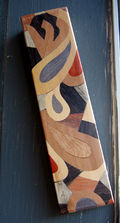Ceramic art


In art history, ceramics and ceramic art mean art objects such as figures, tiles, and tableware made from clay and other raw materials by the process of pottery. Some ceramic products are regarded as fine art, while others are regarded as decorative, industrial or applied art objects, or as artifacts in archaeology. They may be made by one individual or in a factory where a group of people design, make and decorate the ware. Decorative ceramics are sometimes called "art pottery".[1]
The word "ceramics" comes from the Greek keramikos (κεραμικος), meaning "pottery", which in turn comes from keramos (κεραμος), meaning "potter's clay." [2] Most traditional ceramic products were made from clay (or clay mixed with other materials), shaped and subjected to heat, and tableware and decorative ceramics are generally still made like that. In modern ceramic engineering usage, ceramics is the art and science of making objects from inorganic, non-metallic materials by the action of heat. It excludes glass and mosaic made from glass tesserae.
There is a long history of ceramic art in almost all developed cultures, and often ceramic objects are all the artistic evidence left from vanished cultures, like that of the Nok in Africa over 2,000 years ago. Cultures especially noted for fine ceramics include the Chinese, Cretan, Greek, Persian, Mayan, Japanese, Dominican, and Korean cultures, as well as the modern Western cultures.
Elements of ceramic art, upon which different degrees of emphasis have been placed at different times, are the shape of the object, its decoration by painting, carving and other methods, and the glazing found on most ceramics.
Contents |
Prehistoric pottery

Early pots were made by the "coiling" method, working the clay into a long string which was wound round to form a shape and then modelled to form smooth walls. The potter's wheel was probably invented in Mesopotamia by the 4th millennium BC, but spread across nearly all Eurasia and much of Africa, though it remained unknown in the New World until the arrival of Europeans. Decoration of the clay by incising and painting is found very widely, and was initially geometric, but often included figurative designs from very early on.
So important is pottery to the archaeology of prehistoric cultures that many are known by names taken from their distinctive, and often very fine, pottery, such as the Linear Pottery culture, Beaker culture, Globular Amphora culture, Corded Ware culture and Funnelbeaker culture, to take examples only from Neolithic Europe (approximately 7,000-1,800 BCE).
Ceramic art has generated many styles from its own tradition, but is often closely related to contemporary sculpture and metalwork. Many times in its history styles from the usually more prestigious and expensive art of metalworking have been copied in ceramics. This can be seen in early Chinese ceramics, such as pottery and ceramic-wares of the Shang Dynasty, in Ancient Roman and Iranian pottery, and Rococo European styles, copying contemporary silverware shapes. A common use of ceramics is for "pots" - containers such as bowls, vases and amphorae, as well as other tableware, but figurines have been very widely made.
Ceramics as wall decoration

The earliest evidence of glazed brick is the discovery of glazed bricks in the Elamite Temple at Chogha Zanbil, dated to the 13th century BCE. Glazed and coloured bricks were used to make low reliefs in Ancient Mesopotamia, most famously the Ishtar Gate of Babylon (ca. 575 BCE), now partly reconstructed in Berlin, with sections elsewhere. Mesopotamian craftsmen were imported for the palaces of the Persian Empire such as Persepolis. The tradition continued, and after the Islamic conquest of Persia coloured and often painted glazed bricks or tiles became an important element in Persian architecture, and from there spread to much of the Islamic world, notably the İznik pottery of Turkey under the Ottoman Empire in the 16th and 17th centuries.
Transmitted via Islamic Spain, a new tradition of Azulejos developed in Spain and especially Portugal, which by the Baroque period produced extremely large painted scenes on tiles, usually in blue and white. Delftware tiles, typically with a painted design covering only one (rather small) tile, were ubiquitous in Holland and widely exported over Northern Europe from the 16th century on. Several 18th century royal palaces had porcelain rooms with the walls entirely covered in porcelain. Surviving examples include ones at Capodimonte, Naples, the Royal Palace of Madrid and the nearby Royal Palace of Aranjuez.[3] Elaborate tiled stoves were a feature of rooms of the middle and upper-classes in Northern Europe from the 17th to 19th centuries.
There are several other types of traditional tiles that remain in manufacture, for example the small, almost mosaic, brightly coloured zellige tiles of Morocco. With exceptions, notably the Porcelain Tower of Nanjing, tiles or glazed bricks do not feature largely in East Asian ceramics.
East Asia
China
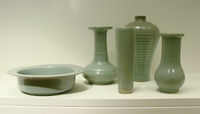
Yuchanyan Cave in Hunan, China yielded sherds of ceramic vessels and other artifacts which were dated by analysis of charcoal and bone collagen, giving a date range of 17,500 to 18,300 years old for the pottery.[5] The pottery specimens may be the oldest known examples of pottery anywhere in the world,[6] and provide some of the earliest evidence for pottery making in China. Pottery which dates back to 10,000 BCE has also been excavated in China.[6][7][8]
There is Chinese porcelain from the late Eastern Han period (100 to 200 AD), the Three Kingdoms period (220 to 280 AD), the Six Dynasties period (220 to 589 AD), and thereafter. China in particular has had a continuous history of large-scale production, with the Imperial factories usually producing the best work. The Tang Dynasty (618 to 906 AD) is especially noted for grave goods figures of humans, animals and model houses, boats and other goods, excavated (usually illegally) from graves in large numbers.
The Imperial porcelain of the Song Dynasty (960–1279), featuring very subtle decoration shallowly carved by knife in the clay, is regarded by many authorities as the peak of Chinese ceramics, though the large and more exuberantly painted ceramics of the Ming Dynasty (1368–1644) have a wider reputation.
Chinese emperors gave ceramics as diplomatic gifts on a lavish scale, and the presence of Chinese ceramics no doubt aided the development of related traditions of ceramics in Japan and Korea in particular.
Japan
The earliest Japanese pottery was made around the 11th millennium BC. Jōmon ware emerged in the 6th millennium BC and the plainer Yayoi style in about the 4th century BC. This early pottery was soft earthenware, fired at low temperatures. The potter’s wheel and a kiln capable of reaching higher temperatures and firing stoneware appeared in the 3rd or 4th centuries AD, probably brought by southern Korean potters. In the 8th century, official kilns in Japan produced simple, green lead glazed wares. Unglazed stoneware was used funerary jars, storage jars and kitchen pots up to the 17th century. Some of the kilns improved their methods and are known as the “Six Old Kilns”.
From the 11th to the 16th century, Japan imported much porcelain from China and some from Korea. The Japanese overlord Toyotomi Hideyoshi's attempts to conquer China in the 1590s were dubbed the "Ceramic Wars" because the emigration of Korean potters appeared to be a major cause. One of these potters, Yi Sam-pyeong, discovered the raw material of porcelain in Arita and produced first true porcelain in Japan.
In the 17th century, conditions in China drove some of its potters into Japan, bringing with them the knowledge to make refined porcelain. From the mid-century, the Dutch East India Company began to import Japanese porcelain into Europe. At this time, Kakiemon wares were produced at the factories of Arita, which had much in common with the Chinese Famille Verte style. The superb quality of its enamel decoration was highly prized in the West and widely imitated by the major European porcelain manufacturers. In 1971 it was declared an important "intangible cultural treasure" by the Japanese government.
In the twentieth century, interest in the art of the village potter was revived by the Mingei folk movement led by potters Shoji Hamada, Kawai Kajiro and others. They studied traditional methods in order to preserve native wares that were in danger of disappearing. Modern masters use ancient methods to bring pottery and porcelain to new heights of achievement at Shiga, Ige, Karatsu, Hagi, and Bizen. A few outstanding potters were designated living cultural treasures (mukei bunkazai 無形文化財). In the old capital of Kyoto, the Raku family continued to produce the rough tea bowls that had so delighted connoisseurs. At Mino, potters continued to reconstruct the classic formulas of Momoyama-era Seto-type tea wares of Mino, such as Oribe ware. By the 1990s many master potters worked away from ancient kilns and made classic wares in all parts of Japan.
Korea
Korean pottery has had a continuous tradition since simple earthenware from about 8000 BCE. Styles have generally been a distinctive variant of Chinese, and later Japanese, developments. The ceramics of the Goryeo Dynasty (918–1392) and early Joseon white porcelain of the following dynasty are generally regarded as the finest achievements.
Western Asia and the Middle East
Islamic pottery

From the eighth to eighteenth centuries, glazed ceramics was important in Islamic art, usually in the form of elaborate pottery,[9] developing on vigorous Persian and Egyptian pre-Islamic traditions in particular. Tin-opacified glazing was developed by the Islamic potters, the first examples found as blue-painted ware in Basra, dating from about the 8th century. The Islamic world had contact with China, and increasingly adapted many Chinese decorative motifs. Persian wares gradually relaxed Islamic restrictions on figurative ornament, and painted figuratives scenes became very important.
Stoneware, originating from 9th century Iraq, was also an important material in Islamic pottery.[10] Pottery was produced in Ar-Raqqah, Syria, in the 8th century.[11] Other centers for innovative ceramics in the Islamic world were Fustat (near modern Cairo) from 975 to 1075, Damascus from 1100 to around 1600 and Tabriz from 1470 to 1550.[12]
The the albarello form, a type of maiolica earthenware jar originally designed to hold apothecaries' ointments and dry drugs, was first made in the Islamic Middle East. It was brought to Italy by Hispano-Moresque traders; the earliest Italian examples were produced in Florence in the 15th century.
Iznik pottery, made in western Anatolia, is highly decorated ceramics whose heyday was the late sixteenth century under the Ottoman sultans. Iznik vessels were originally made in imitation of Chinese porcelain, which was highly prized. Under Süleyman the Magnificent (1520–66), demand for Iznik wares increased. After the conquest of Constantinople in 1453, the Ottoman sultans started a programme of building, which used large quantities of Iznik tiles. The Sultan Ahmed Mosque in Istanbul (built 1609-16) alone contains 20,000 tiles and tiles were used extensively in the Topkapi Palace (commenced 1459). As a result of this demand, tiles dominated the output of the Iznik potteries.
Europe
Early figurines
The earliest known ceramic objects are the Gravettian figurines from the Upper Paleolithic period, such as those discovered at Dolní Věstonice in the modern-day Czech Republic. The Venus of Dolní Věstonice (Věstonická Venuše in Czech) is a statuette of a nude female figure dating from some time between 29,000 and 25,000 BCE.[13] It was made by moulding and then firing a mixture of clay and powdered bone.[14] Similar objects in various media found throughout throughout Europe and Asia and dating from the Upper Paleolithic period have also been called Venus figurines. Scholars are not agreed as to their purpose or cultural significance.
The ancient Mediterranean
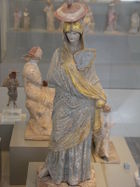
Glazed Egyptian faience goes back to the third millennium BC, with painted but unglazed pottery developed even earlier in the Naqada culture. Faience became sophisticated and produced on a large scale, using moulds as well modelling, and later also throwing on the wheel. Several methods of glazing were developed, but colours remained largely limited to a range in the blue-green spectrum.
On the Greek island of Santorini are some of the earliest finds created by the Minoans dating to the third millennium BC, with the original settlement at Akrotiri dating to the fourth millennium BC;[15] excavation work continues at the principal archaeological site of Akrotiri. Some of the excavated homes contain huge ceramic storage jars known as pithoi.
Ancient Grecian and Etruscan ceramics are renowned for their figurative painting, especially in the black-figure and red-figure styles. Moulded Greek terracotta figurines, especially those from Tanagra, were small figures, often religious but later including many of everyday genre figures, apparently used purely for decoration.
Ancient Roman pottery, such as Samian ware, was rarely as fine, and largely copied shapes from metalwork, but was produced in enormous quantities, and is found all over Europe and the Middle East, and beyond. Monte Testaccio is a waste mound in Rome made almost entirely of broken amphorae used for transporting and storing liquids and other products. Few vessels of great artistic interest have survived, but there are very many small figures, often incorporated into oil lamps or similar objects, and often with religious or erotic themes (or both together - a Roman speciality). The Romans generally did not leave grave goods, the best source of ancient pottery, but even so they do not seem to have had much in the way of luxury pottery, unlike Roman glass, which the elite used with gold or silver tableware. The more expensive pottery tended to use relief decoration, often moulded, rather than paint. Especially in the Eastern Empire, local traditions continued, hybridizing with Roman styles to varying extents.
Tin-glazed pottery
Tin-glazed pottery, or faience, originated in Iraq in the ninth century, from where it spread to Egypt, Persia and Spain before reaching Italy in the Renaissance, Holland in the 16th century and England, France and other European countries shortly after. Important regional styles in Europe include: Hispano-Moresque, maiolica, Delftware, and English Delftware. By the High Middle Ages the Hispano-Moresque ware of Al-Andaluz was the most sophisticated pottery being produced in Europe, with elaborate decoration. It introduced tin-glazing to Europe, which was developed in the Italian Renaissance in maiolica. Tin-glazed pottery was taken up in the Netherlands from the sixteenth to the eighteenth centuries, the potters making household, decorative pieces and tiles in vast numbers,[16] usually with blue painting on a white ground. Dutch potters took tin-glazed pottery to the British Isles, where it was made between about 1550 and 1800. In France, tin-glaze was begun in 1690 at Quimper in Brittany [1], followed in Rouen, Strasbourg and Lunéville. In the 18th century, Josiah Wedgwood (1730–1795) formulated a white earthenware body from which he could make light and durable tablewares. As these were almost as white as tin-glazed pottery and better in other ways, they replaced it in the 19th century. There has been a revival in the twentieth century by studio potters.
Porcelain
For several centuries Chinese porcelain had reached Europe in an expensive trickle, and from the 16th century onwards there were attempts to imitate it, such as the soft-paste Medici porcelain made in Florence. None was successful until a recipe for hard-paste porcelain was devised at the Meissen factory in Dresden in 1710. Within a few years, porcelain factories sprung up at Nymphenburg in Bavaria (1754) and Capodimonte in Naples (1743) and many other places, often financed by a local ruler.
Soft-paste porcelain was made at Rouen in the 1680s, but the first important production was at St.Cloud, letters-patent being granted in 1702. The Duc de Bourbon established a soft-paste factory, the Chantilly porcelain, in the grounds of his Château de Chantilly in 1730; a soft-paste factory was opened at Mennecy; and the Vincennes factory was set up by workers from Chantilly in 1740, moving to larger premises at Sèvres[17] in 1756. The superior soft-paste made at Sèvres put it in the leading position in Europe in the second half of the 18th century.[18] The first soft-paste in England was demonstrated in 1742, apparently based on the Saint-Cloud formula. In 1749 a patent was taken out on the first bone china, subsequently perfected by Josiah Spode. The main English porcelain makers in the 18th century were at Chelsea, Bow, St James's, Bristol, Derby and Lowestoft.
Porcelain was ideally suited to the energetic Rococo curves of the day. The products of these early decades of European porcelain are generally the most highly regarded, and expensive. The Meissen modeler Johann Joachim Kaendler and Franz Anton Bustelli of Nymphenburg are perhaps the most outstanding ceramic artists of the period. Like other leading modelers, they trained as sculptors and produced models from which moulds were taken.
By the end of the 18th century owning porcelain tableware and decorative objects had become obligatory among the prosperous middle-classes of Europe, and there were factories in most countries, many of which are still producing. As well as tableware, early European porcelain revived the taste for purely decorative figures of people or animals, which had also been a feature of several ancient cultures, often as grave goods. These were still being produced in China as blanc de Chine religious figures, many of which had reached Europe. European figures were almost entirely secular, and soon brightly and brilliantly painted, often in groups with a modelled setting, and a strong narrative element (see picture).
Wedgwood and the North Staffordshire Potteries
crop.jpg)
From the 17th century, Stoke-on-Trent in North Staffordshire emerged as a major centre of pottery making.[19] Important contributions to the development of the industry were made by the firms of Wedgwood, Spode, Royal Doulton and Minton.
The local presence of abundant supplies of coal and suitable clay for earthenware production led to the early but at first limited development of the local pottery industry. The construction of the Trent and Mersey Canal enabled the import of china clay from Cornwall together with other materials and facilitated the production of creamware and bone china. Other production centres had a lead in the production of high quality wares but the preeminence of North Staffordshire was brought about by methodical and detailed research and a willingness to experiment carried out over many years, initially by one man, Josiah Wedgwood. His lead was followed by other local potters, scientists and engineers.
Wedgwood is credited with the industrialization of the manufacture of pottery. His work was of very high quality: when visiting his workshop, if he saw an offending vessel that failed to meet with his standards, he would smash it with his stick, exclaiming, "This will not do for Josiah Wedgwood!" He was keenly interested in the scientific advances of his day and it was this interest that underpinned his adoption of its approach and methods to revolutionize the quality of his pottery. His unique glazes began to distinguish his wares from anything else on the market. His matt finish jasperware in two colours was highly suitable for the Neoclassicism of the end of the century, imitating the effects of Ancient Roman carved gemstone cameos like the Gemma Augustea, or the cameo glass Portland Vase, of which Wedgwood produced copies.
He also is credited with perfecting transfer-printing, first developed in England about 1750. By the end of the century this had largely replaced hand-painting for complex designs, except at the luxury end of the market, and the vast majority of the world's decorated pottery uses versions of the technique to the present day.
Stoke-on-Trent's supremacy in pottery manufacture nurtured and attracted a large number of ceramic artists including Clarice Cliff, Susie Cooper, Lorna Bailey, Charlotte Rhead, Frederick Hurten Rhead and Jabez Vodrey.
Studio pottery in Britain
Studio pottery is made by artists working alone or in small groups, producing unique items or short runs, typically with all stages of manufacture carried out by one individual.[20] It is represented by potters all over the world but has strong roots in Britain, with potters such as Bernard Leach, William Staite Murray, Dora Billington, Lucie Rie and Hans Coper. Bernard Leach (1887–1979) established a style of pottery influenced by Far-Eastern and medieval English forms. After briefly experimenting with earthenware, he turned to stoneware fired to high temperatures in large oil- or wood-burning kilns. This style dominated British studio pottery in the mid-20th century. The Austrian refugee Lucie Rie (1902–1995) has been regarded as essentially a modernist who experimented with new glaze effects on often brightly coloured bowls and bottles. Hans Coper (1920–1981) produced non-functional, sculptural and unglazed pieces. After the Second World War, studio pottery in Britain was encouraged by the wartime ban on decorating manufactured pottery and the modernist spirit of the Festival of Britain. The simple, functional designs chimed in with the modernist ethos. Several potteries were formed in response to this fifties boom, and this style of studio pottery remained popular into the nineteen-seventies.[21]
The Americas


Native American pottery
The people in North, Central, and South America continents had a wide variety of pottery traditions before Europeans arrived. The oldest ceramics known in the Americas — made from 5,000 to 6,000 years ago — are found in the Andean region, along the Pacific coast of Ecuador at Valdivia and Puerto Hormiga, and in the San Jacinto Valley of Colombia; objects from 3,800 to 4,000 years old have been discovered in Peru. Some archaeologists believe that ceramics know-how found its way by sea to Mesoamerica, the second great cradle of civilization in the Americas.[22]
The best-developed styles found in the central and southern Andes are the ceramics found near the ceremonial site at Chavín de Huántar (800–400 B.C.) and Cupisnique (1000–400 B.C.). During the same period, another culture developed on the southern coast of Peru, in the area called Paracas. The Paracas culture (600–100 B.C.) produced marvelous works of embossed ceramic finished with a thick oil applied after firing. This colorful tradition in ceramics and textiles was followed by the Nazca culture (A.D. 1–600), whose potters developed improved techniques for preparing clay and for decorating objects, using fine brushes to paint sophisticated motifs. In the early stage of Nazca ceramics, potters painted realistic characters and landscapes.
The Moche cultures (A.D. 1–800) that flourished on the northern coast of modern Peru produced modelled clay sculptures and effigies decorated with fine lines of red on a beige background. Their pottery stands out for its huacos portrait vases, in which human faces are shown expressing different emotions — happiness, sadness, anger, melancholy — as well for its complicated drawings of wars, human sacrifices, and celebrations.[23]
The Mayans were a relative latecomer to ceramic development, as their ceramic arts flourished in the Maya Classic Period, or the second to tenth century AD. One important site in southern Belize is known as Lubaantun, that boasts particularly detailed and prolific works. As evidence of the extent to which these ceramic art works were prized, many specimens traced to Lubaantun have been found at distant Mayan sites in Honduras and Guatemala.[24] Furthermore, the current Mayan people of Lubaantun continue to hand produce copies of many of the original designs found at Lubaantun.
In the United States, the oldest pottery dates to 2500 BC. It has been found in the Timucuan Ecological and Historic Preserve in Jacksonville, Florida, and some slightly older along the Savannah River in Georgia.[25]
The Hopi in Northern Arizona and several other Puebloan peoples including the Taos, Acoma, and Zuñi people (all in the Southwestern United States) are renowned for painted pottery in several different styles. Nampeyo [26] and her relatives created pottery that became highly sought after beginning in the early 20th century. Pueblo tribes in he state of New Mexico have styles distinctive to each of the various pueblos (villages). They include Santa Clara Pueblo, Taos Pueblo, Hopi Pueblos, San Ildefonso Pueblo, Acoma Pueblo and Zuni Pueblo, amongst others. Some of the renowned artists of Pueblo pottery include: Nampeyo, Elva Nampeyo, and Dextra Quotskuyva of the Hopi; Leonidas Tapia of San Juan Pueblo; and Maria Martinez and Julian Martinez of San Ildefonso Pueblo. In the early 1900s Martinez and her husband Julian rediscovered the method of creating traditional San Ildefonso Pueblo Black-on Black pottery.
Studio pottery in the United States
- See also: Category: American potters
There is a strong tradition of studio artists working in ceramics in the United States. It had a period of growth in the 1960s and continues to present times. Many fine art, craft, and contemporary art museums have pieces in their permanent collections, and exhibit them.
Beatrice Wood was an American artist and studio potter located in Ojai, California. She developed a unique form of luster-glaze technique, and was active from the 1930s to her death in 1998 at 105 years old. Robert Arneson created larger sculptural work, in an abstracted representational style. There are ceramics arts departments at many colleges, universities, and fine arts institutes in the United States.
Sub-Saharan Africa
Pottery in Sub-Saharan Africa is traditionally made by coiling and is fired at low temperature. The figurines of the ancient Nok culture, whose function remains unclear, are an example of high-quality figural work, found in many cultures, such as the Benin of Nigeria.
Ladi Kwali, a Nigerian potter who worked in the Gwari tradition, made large pots decorated with incised patterns. Her work is an interesting hybrid of traditional African with western studio pottery. Magdalene Odundo is a Kenyan-born British studio potter whose ceramics are hand built and burnished.
Gallery
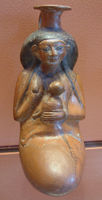 Ancient Egyptian ceramic art, Louvre Museum. |
 Ceramic goblet from Navdatoli, Malwa, India, 1300 BCE. |
 A funerary urn in the shape of a "bat god" or a jaguar, from Oaxaca, Mexico, dated to AD 300–650. Height: 9.5 in (23 cm). |
 Luca della Robbia, Virgin and Child with John the Baptist |
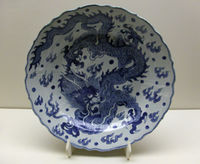 Ming Dynasty plate depicting dragons, in the classic blue on white |
 18th century tiled stove in the Catherine Palace, St Petersburg |
 Hopi olla, 19th century, artist unknown, Stanford Museum collections. |
Industrial art example: "Korean girl." Meissen porcelain museum. |
 Group with lovers, modelled by Franz Anton Bustelli, Nymphenburg, 1756. |
,_1997,_Metropolitan_Museum_of_Art.jpg) Red terracotta carbonized vessel, Magdalene Odundo, 1997. |
Ceramic art display, 1963 |
See also
- Ceramics museum
- Native American pottery
References
- ↑ "Art Pottery Manufacturers and Collectors". http://www.artpotterymanufacturers.com/Welcome.html. Retrieved 2003-01-05.
- ↑ The Webster Encyclopedic Dictionary
- ↑ Porcelain Room, Aranjuez Comprehensive but shaky video
- ↑ http://www.britannica.com/ebc/article-9384284 Britannica Online
- ↑ cite news | first= | last= | url=http://www.pnas.org/content/early/2009/06/01/0900539106.abstract | title=Radiocarbon dating of charcoal and bone collagen associated with early pottery at Yuchanyan Cave, Hunan Province, China | work= | publisher=Proceedings of the National Academy of Sciences of the United States of America | date=June 1, 2009 | accessdate=2009-12-29
- ↑ 6.0 6.1 'Oldest pottery' found in China
- ↑ http://arheologija.ff.uni-lj.si/documenta/pdf29/29chi.pdf
- ↑ Diamond, Jared (June 1998). "Japanese Roots". Discover (Discover Media LLC). http://www.discover.com/issues/jun-98/features/japaneseroots1455/. Retrieved 2006-03-23.
- ↑ Mason, Robert B. (1995). "New Looks at Old Pots: Results of Recent Multidisciplinary Studies of Glazed Ceramics from the Islamic World". Muqarnas: Annual on Islamic Art and Architecture (Brill Academic Publishers) XII. ISBN 9004103147. Mason (1995), p. 1
- ↑ Mason (1995), p. 5
- ↑ Henderson, J.; McLoughlin, S. D.; McPhail, D. S. (2004). "Radical changes in Islamic glass technology: evidence for conservatism and experimentation with new glass recipes from early and middle Islamic Raqqa, Syria". Archaeometry 46 (3): 439–68. doi:10.1111/j.1475-4754.2004.00167.x
- ↑ Mason (1995), p. 7
- ↑ No. 359: The Dolni Vestonice Ceramics
- ↑ Chris Stringer. Homo Britannicus, Alan Lane, 2006, ISBN 9780713997958.
- ↑ Archaeological site of Akrotiri, Santorini, Greece
- ↑ Caiger-Smith, Alan, Tin Glazed Pottery, Faber and Faber, 1973
- ↑ Metropolitan Museum of Art
- ↑ Metropolitan Museum of Art
- ↑ thepotteries.org
- ↑ Emmanuel Cooper, Ten Thousand Years of Pottery (British Museum Press, 2000) ISBN 0-7141-2701-9
- ↑ Harrod, Tanya, "From A Potter's Book to The Maker's Eye: British Studio Ceramics 1940-1982", in The Harrow Connection, Northern Centre for Contemporary Art, 1989
- ↑ The New York Times, Art Review Museum of American Indian's 'Born of Clay' Explores Culture Through Ceramics By GRACE GLUECK, Published: July 1, 2006
- ↑ Born of Clay - Ceramic from the National Museum of the American Indian, 2005 Smithsonian Institution
- ↑ C. M.Hogan, Comparison of Mayan sites in southern and western Belize, Lumina Technologies (2006)
- ↑ Soergel, Matt (18 Oct 2009). "The Mocama: New name for an old people". The Florida Times-Union. http://jacksonville.com/news/metro/2009-10-18/story/the_mocama_new_name_for_an_old_people. Retrieved May 12, 2010.
- ↑ A Nampeyo Showcase, a display of some of Nampeyo's work
- ↑ http://ourhouse.ninemsn.com.au/ourhouse/factsheets/db/artanddesign/02/266.asp
Further reading
- de Waal, Edmund. A Ceramic History: Pioneering Definitions 1900–1940 The Studio Pot. File retrieved February 10, 2007.
External links
- Ceramic history for potters by Victor Bryant
- Potweb Online catalogue & more from the Ashmolean Museum
- Minneapolis Institute of Arts: Ceramics - The Art of Asia
- Ceramic features from the Victoria & Albert Museum
- Index to the Metropolitan Museum Timeline of Art History - see "ceramics" for many features
- Art Pottery and Industry
|
||||||||||||||||||||||


